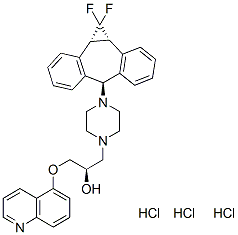
LY335979 (Zosuquidar trihydrochloride) is a selective Pgp (P-glycoprotein) inhibitor with a Ki of 59 nM. LY335979 displays the following characteristics of an 'ideal modulator' of Pgp-mediated multidrug resistance: high affinity binding to Pgp, high potency for in vitro reversal of compound resistance, high therapeutic index (activity was demonstrated at doses ranging from 1-30 mg/kg) observed in in vivo antitumor efficacy experiments, and a lack of pharmacokinetic interactions that alter the plasma concentration of coadministered oncolytic agents. These desirable features strongly suggest that LY335979 is an exciting new clinical agent to test the hypothesis that inhibition of P-glycoprotein activity will result in reversal of multidrug resistance in human tumors. LY335979 was without significant effect on the pharmacokinetics of these anticancer agents.
<span style='color:#ff0000;'><strong>*The compound is unstable in solutions, freshly prepared is recommended</strong></span>
| Cell Experiment | |
|---|---|
| Cell lines | MCF-7 and MCF-7/ADR cells |
| Preparation method | Cytotoxicity Assays. Cell viability was determined using a modified 3-(4,5-dimethylthiazol-2-yl)-2,5-diphenyltetrazolium bromide dye reduction method. Cells were harvested during logarithmic growth phase, and seeded in 96-well plates (Costar) at 7.5X104 cells/well. The cells were then cultured for 72 h in the presence of oncolytics with or without modulators. MCF-7 and MCF-7/ADR cells were incubated 24 h before the addition of the drug with and without the modulator. Modulators were prepared as 2 mM DMSO stocks and added to wells to give final concentrations ranging from 0.05 to 5 uM. After 72 h, 20 ul of freshly prepared 3-(4,5-dimethylthiazol-2- yl)-2,5-diphenyltetrazolium bromide (5 mg/mL in Dulbecco's PBS) was added to each well and incubated for 4 h in a 37°C incubator containing 5% CO2. Cells were pelleted in a Sorvall RT6000B centrifuge, 70 p.1of medium was carefully removed from each well, and 100ul of 2-propanol/0.04 N HC1 was added. Cells were resuspended 5-10 times with a Multipipettor or until no particulate matter was visible. Plates were immediately read on a Titertek Multiskan MCC/340 microplate reader Flow Laboratories (McLean, VA) with a test wavelength of 570 nm and a reference wavelength of 630 nm.Controls were measured in quadruplicate and modulators were measured in duplicate. Cytotoxicity analyses were also performed using the CeliTiter 96 AQueous assay kit (Promega Corp., Madison, WI) according to the manufacturer's instructions. |
| Concentrations | 0.05~5µM |
| Incubation time | 72h |
| Animal Experiment | |
|---|---|
| Animal models | P388/ADR tumors bearing mice |
| Formulation | stock solution was 2.5 to 5 mg/nil in 5% manrntol |
| Dosages | 20 mg/kg once daily for 5 days |
| Administration | i.v. injection |
| Molecular Weight | 637.00 |
| Formula | C32H31F2N3O2.3HCl |
| CAS Number | 167465-36-3 |
| Solubility (25°C) | DMSO ≥35 mg/mL |
| Storage |
Powder -20°C 3 years ; 4°C 2 years In solvent -80°C 6 months ; -20°C 1 month |
| Species | Mouse | Rat | Rabbit | Guinea pig | Hamster | Dog |
| Weight (kg) | 0.02 | 0.15 | 1.8 | 0.4 | 0.08 | 10 |
| Body Surface Area (m2) | 0.007 | 0.025 | 0.15 | 0.05 | 0.02 | 0.5 |
| Km factor | 3 | 6 | 12 | 8 | 5 | 20 |
| Animal A (mg/kg) = Animal B (mg/kg) multiplied by | Animal B Km |
| Animal A Km |
For example, to modify the dose of Compound A used for a mouse (20 mg/kg) to a dose based on the BSA for a rat, multiply 20 mg/kg by the Km factor for a mouse and then divide by the Km factor for a rat. This calculation results in a rat equivalent dose for Compound A of 10 mg/kg.
| Related P-glycoprotein Products |
|---|
| Reversin 121
Reversin 121 is a P-glycoprotein inhibitor. |
| Reversin 205
Reversin 205 ([Boc-Glu(Obzl)]2-Lys-Ome) is a P-glycoprotein (ABCB1) inhibitor. |
| P-gb-IN-1
P-gb-IN-1 inhibitor. |
| P-gp inhibitor 13
P-gp inhibitor 13 is a P-gp inhibitor. |
| ABCB1-IN-1
ABCB1-IN-1 is a potent ABCB1 inhibitor. |


Products are for research use only. Not for human use. We do not sell to patients.
© Copyright 2010-2023 AbMole BioScience. All Rights Reserved.
